Who Will Represent the Musicians?
The Boston Globe recently published an article titled “Pay to Play – strict enforcement of copyright’s jeopardizing live music in small venues”. The piece revealed how small music venues and coffee shops across New England have recently been targeted by PRO’s (Performance Rights Organizations) regarding the payment of licensing fees. Many of these venues, ranging from library cafés to coffee houses and eateries in strip malls, feature local performers playing music that varies from originals to covers, often playing for tips.
Any venue in which music is publicly performed is required by copyright law to purchase a performance license. Licensing fees also apply to recorded music as well. In the United States there are three PRO’s; ASCAP, BMI, and SESAC who collect these fees and distribute them to the songwriters. For any given venue, the licensing fee is determined by its size and seating capacity, the number of weekly performances, and its sales revenue among other factors. $300 yearly is a rough average for a small coffeehouse, essentially a dollar a day.
The debate has been long-lived regarding why it is necessary for a small venue that features mainly original music to pay a licensing fee, as they are not benefiting from the music of big-time songwriters. Or why should a venue that only has cover bands have to pay a fee, as obviously there’s no way of keeping track of all the different songs that are played over the course of a year making it impossible for all of those songwriters to be compensated. (It is noteworthy to mention that only venues are charged these fees, not performers).
Many businesses use music to enhance their operations, and the flipside of this argument is that these fees are simply the cost of doing business. Whether a coffee shop has original or cover performers, either way, they are having live music at their venue because it helps increase their business. While songwriters are not paid every time a local band covers their songs in some small town bar, the bar and the songwriters do benefit from the performance of that song. The bar benefits because the performance of popular music is a part of their business, if it wasn’t, they wouldn’t have it. The songwriters benefit because this live performance is essentially free advertising and inevitably must contribute to its popularity and increased overall sales.
Another way to look at this would be that it is no different than paying for a liquor license. If you want to serve beer, you’re paying a fee for the right to serve beer. While it might seem strange that the PRO’s collect fees for the performance of songs written by their members and yet these songwriters don’t receive any payment for these specific performances, the PRO’s do collect and disperse fees for all the countable plays of a given song. This wouldn’t happen for the songwriters if these organizations did not exist.
But society wouldn’t benefit from live music on a local level if there were no musical performers to play these songs. What entity represents this part of the equation.
Nightclubs, restaurants, concert halls, supermarkets – these businesses are all enhanced by the performance of music, be it recorded or performed live. If their business is enhanced by music, paying a fee for the right to do so only seems logical (assuming that the songwriters of the world continue to be paid for their work). So the business owners profits from having music or they wouldn’t be in business. The songwriters profit from writing songs or they wouldn’t be songwriters. But where does the performer fit into all this? It is a commonly known fact that most musical performers are greatly under paid for their services. Most musicians that earn a good living from their craft are either touring musicians, or part of a small, elite group of professional recording musicians, most likely in one of our three major music production cities. Overall, this is a very small percentage of those involved in music performance. Much of the live music that most people ever hear is performed by local bands and coffeehouse performers and the pay scale for most in that world is typically low.
Who will ever represent a performing musicians right for fair compensation for his or her work? 20 or 30 years ago $100 per night per player was considered good pay. In 2010, $100 per night is still considered good pay, yet inflation and cost of living increases essentially deem this as an across-the-board pay cut. Should we reevaluate our current system of PRO’s to help compensate the performers of the world? Should musicians unions revamp their approach to help this problem? Is a new type of organization needed? Music is, and has always been, an important part of our society, and the development of music as a cultural art has been greatly undervalued in recent years. If the value of musicians, and the pay that goes with that, continues to decline, who will even be able to afford to be a musician in the future?
Who will represent the musicians?
Jamming with Oteil
During the summer of 2008 when the Rhett Akins band was between bass players, our sound engineer Penn Robertson threw out the idea of calling his friend Oteil Burbridge to sub a few gigs, as he was currently on hiatus from his regular gig with the Allman Brothers. Apparently the brothers were on an extended break that summer and Oteil happened to be available and interested in coming out with us. The next thing I knew we were doing a handful of gigs with him and riding around on a bus listening to first-hand stories about my childhood idols. While the gigs and stories were great fun, it was the sound checks that were most memorable.
As Rhett and band are well-versed in the Allman Brothers classic material, our sound checks during this time period contained several songs from their repertoire; Blue Sky, Statesboro Blues, Don’t Keep Me Wonderin’, and Aint Wastin’ Time No More. These moments contained some great improvised jams propelled by Oteil’s masterful groove and melodic sensibility. It was almost as if a little piece of one of America’s greatest bands fell from the sky and landed on our doorstep, to be shared only in the moment with a few appreciative friends. Eventually our stint with Oteil came to an end but it was an inspired road to travel on while it lasted. One I will always remember with fondness and never forget. Thanks Oteil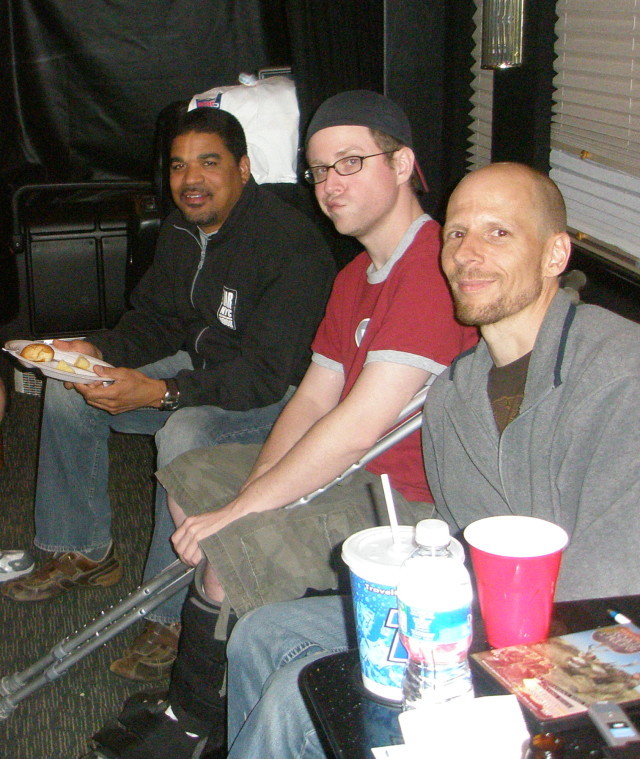
Multiband Shows are all about Organization and Teamwork
Multi-band shows on any level, be it a national act with a local opener in a concert hall, a battle of the bands at a local high school, or the Bonnaroo Festival, can be a great musical experience for both the performers, and audience. They can also be a logistical nightmare for event organizers, production companies, crew members, and the musicians. The key to these kinds of events running smoothly is highly organized and coordinated advanced planning and an overall spirit of teamwork.
Typically, the most well run multi-band shows have a designated stage manager, usually hired by the event, the production company, or the headlining act. In the days and weeks prior to the event, the stage manager will coordinate between the event buyer, the production company, local crew, and the tour managers of the bands and artists involved. In a perfect world, the proper planning and effort will result in a painless day of load-ins and load-outs, sound checks, line checks, and performances, all happening glitch free and on-time. Unfortunately, we don’t live in a perfect world.
Some of the problems that can arise might range from performers and equipment arriving late, bad weather, equipment problems, a shortage of stagehands, ineffective communication, and often, just poor planning. I was recently involved in a show that suffered from literally all of these problems.
At any multi-band show, especially on a national level, there are some unspoken rules and protocols that come into play. If the event has hired a national act, they probably signed a contract and agreed to the terms of that acts rider. Usually these riders will provide very specific guidelines regarding all of the details pertaining to the daily activities and performance requirements of that artist or band. In many situations, it also gives the artist and tour manager final say regarding opening acts, set lengths, backstage traffic, etc. All of this must be mutually agreeable in advance, but after both parties have signed off on the rider, each will have specific responsibilities and expectations. In short, the tour manager of the headlining act and the event buyer will have complete authority over the performance related events of a given show day.
If there is more than one national act, the other acts tour managers will also have a big say, but all in accordance to each acts specific rider and the agreements made when the show was advanced. This is where it can get a little grey as some artists riders might conflict with another’s. In these situations an unspoken rule comes into play, that being that the headliner has the ultimate say, followed by the artist with the second billing, followed by third billing, etc. if there are two or more acts that each receive equal billing (co-headliners), there is usually a mutual decision making between tour managers and the event buyer. The lines can become greatly blurred on a smaller scale, such as local bands performing together in a nightclub, or regional festivals, as these situations seldom have signed contracts.
Regardless of a given events level of profile, or organizational efficiency, being a team player is of utmost importance for all involved, especially the musicians.
On a recent Rhett Akins show I worked, we were co-headlining with another national artist, Ashton Shepherd. Several days prior to the show, the events stage manager contacted me and asked if our drummer would be willing to use Ashton’s drummers kit, both to save time, and much-needed stage space. After checking with our drummer, I agreed to this request, as did the band scheduled to play before us, Matt Stillwell. The event had four bands total, and the first band scheduled to play, a regional act, would be setting up their drums in front of the other drum kit. The sound checks were scheduled to take place in reverse order of the performances, and would be starting at 1:00 PM on the day of show for a 4:00 PM showtime. Sounds simple enough, right?
Not. The first thing to throw the schedule off was bad weather, as it rained in the morning pushing back the production set up. Ashton’s band began their set up at 2:00, and it was understood and accepted that the show would probably not start on time. About a half-hour into their set up, I walked out to the stage to discover the openers enormous eight piece drum kit being constructed in the middle of the undersized stage. When I asked the drum tech why he was setting up these drums before the other bands had sound checked, he replied “The stage manager said I have to have these setup by 4:00 no matter what.” I told him that the stage manager was wrong to request this, as there was simply not enough space on the tiny stage for three other bands to set up their backline and sound check. This resulted in a big argument between me and the unyielding drum tech, which resulted in another big argument with the stage manager.
The stage manager didn’t want to budge on his decision, despite the fact that he had discussed none of this with me in advance. Of course he was wrong in his actions, as this kind of decision-making was a complete breach of our rider, in addition to being just plain stupid. So rather than continue with the stalemate, I suggested asking Ashton’s drummer, Brian, if he would be willing to share the use of his kit with one more band. Brian agreed, asking simply that the positioning of his drums not be altered, a request that both Rhett and Matt Stillwell’s drummers had both previously agreed to. Perfect. Problem solved, right?
Nope. When the openers drummer was presented with this option, he said “I can’t play these drums without moving them. I need to change a few things. The height of the symbols, the height and angle of the toms, I need to move the hi hat cymbal stand so I can replace your kick pedal with my double kick pedal.” The look on Brian’s face was that of “you’ve got some nerve, kid”, but in the spirit of making this all work out, he agreed to let this unenlightened fellow make some of these changes.
In the end, it all worked out. The show started late, but all four bands play their shows to an enthusiastic crowd. This story underscores a few great points. Ashton’s drummer presented a grand gesture of goodwill will by offering to share the use of his drum kit. This is not expected in these kinds of situations, and is actually quite rare, but when it is offered, it’s another unspoken rule to simply not move the positioning of the drums, especially when specifically requested. His initial generosity, and his willingness to budge on his own principles for the common good, exemplify the meaning of the phrase ‘team player’. On the contrary, the opening band’s drummer and his tech acted in poor taste. They created an unnecessary tension between musicians and crew members and “took” something that was not offered. They created a feeling of ill will. They were essentially, a stick in the mud.
Every event contains two drastically different groups of people. The people that go to the show, and the people that are working the show. If you’re part of a band and performing at an event that has multiple bands, try to think of yourself as part of a team. A team of musicians, stagehands, crew members, and event staff all working together to present one great day or night of musical performances. You’re all on the same team, and need to work in harmony. You need to watch each other’s backs, protect each other’s gear, and work in a spirit of cooperation, not competition. No matter where you fall in the pecking order, being a team player and working towards the common good of all involved is ultimately what makes a great show. And being organized doesn’t hurt either.
Eclectic Alabama; Adventures in the Valley of Mud
Saturday, June 19, 2010 started out innocent enough when I awoke on our tour bus in a motel parking lot in Montgomery Alabama. The fact that the nearest location of any hotel to this 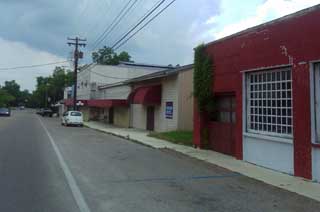 venue was a 30 mile, hour long bus ride, might have been the first clue that this was going to be a rough day. We set out at noon for this four band extravaganza at the Extreme Mud Sports Park in Eclectic, Alabama and the temperature was already into the 90s. The view from the bus window was picturesque as we wound thru this sparsely populated area of rural Alabama. The sky was beginning to cloud up a bit as we turned off the main road and began following a four wheeler down the half-mile or so “gravel” road that led into the park. The road was not in very good shape, and by the time that we realized we might be in trouble if it rained, it was too late, as we we’re already committed with no place to turn around. We came around the final corner to the “concert area” and almost
venue was a 30 mile, hour long bus ride, might have been the first clue that this was going to be a rough day. We set out at noon for this four band extravaganza at the Extreme Mud Sports Park in Eclectic, Alabama and the temperature was already into the 90s. The view from the bus window was picturesque as we wound thru this sparsely populated area of rural Alabama. The sky was beginning to cloud up a bit as we turned off the main road and began following a four wheeler down the half-mile or so “gravel” road that led into the park. The road was not in very good shape, and by the time that we realized we might be in trouble if it rained, it was too late, as we we’re already committed with no place to turn around. We came around the final corner to the “concert area” and almost 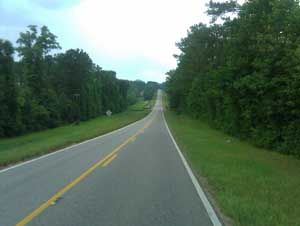 got stuck in the soft ground just backing the bus into place.
got stuck in the soft ground just backing the bus into place.
“If it rains at all, we are never going to get up that hill.” were my first words to one of the event coordinators after a brief introduction. “We got plenty of big tractors round here, don’t worry we’ll getcha out” was the response I got, and I must admit that I felt hardly reassured. I had the runner take our driver Steve to the hotel and then met the ”stage manager”, a local radio station employee whom I will refer to as “Puff the magic DJ”. I deemed him this nickname because he magically organized the daily activities by chain-smoking cigarettes while sitting in a van that was parked about 50 feet from the stage, and facing the opposite direction.
It had already rained a bit that morning, so the sound crew was running behind and our sound check had to be pushed back. We were sharing this bill was Ashton Shepherd, and were allotted the third time slot, scheduled to play at 6 PM just before Ashton. One of the only saving graces of this entire day was a selfless gesture made by Ashton’s drummer, Brian, who volunteered the use of his drum kit to the other bands to save time and stage space. Of course such a grand gesture became needlessly complicated when ‘Puff’ instructed the first band to begin setting up their drums in the middle of this tiny stage during Ashton’s band’s set up. It was inevitably up to me, apparently the only person on site to attend stage-managing school, to sort things out, and the unneeded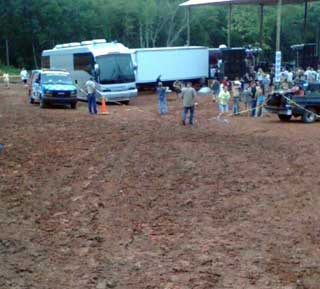 drum kit quickly vanished after a brief conversation between me and the drummers.
drum kit quickly vanished after a brief conversation between me and the drummers.
Then the rain came. It started coming down lightly sometime around 2:30, and by 3:00 it was pouring. At four o’clock it was still pouring. We watched in horror from the bus window as the only exit route, a couple of hundred feet of uphill clay colored dirt in front of us, became a nasty sea of orange mud. Meanwhile, out the other window of the bus, we viewed about 50 or so muddy looking Alabamans standing under the covered stage area in front of the sound equipment now covered in plastic, while mud covered trucks and four wheelers played in a muddy pit just beyond the stage.
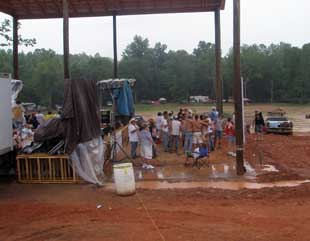 Finally, around 5:30 the rain subsided, and I sent a runner to pick up Steve at the hotel, as we now needed to figure out how we would get the bus out of this hellacious valley of mud. Meanwhile, Ashton’s band finished setting up their backline, and the first band went on just after 6:00. As the event was running two hours behind, we were now foregoing our sound checks and in “throw and go” mode. I asked ‘Puff’ to find us a table and chairs for the merch area (a request that I had previously asked him earlier in the day, earlier in the week by telephone, and in an e-mail). His response came off as this was the first time he was hearing of this and stated “I don’t know what they have here, I’ll work on it. We’ll find something”, and then he hopped back in his smoke-filled van to continue his daylong duty of staring out the window. Needless to say, the requested items never appeared despite further repeated inquiries, although Kelly was able to eventually share a table provided by Matt Stillwell’s band.
Finally, around 5:30 the rain subsided, and I sent a runner to pick up Steve at the hotel, as we now needed to figure out how we would get the bus out of this hellacious valley of mud. Meanwhile, Ashton’s band finished setting up their backline, and the first band went on just after 6:00. As the event was running two hours behind, we were now foregoing our sound checks and in “throw and go” mode. I asked ‘Puff’ to find us a table and chairs for the merch area (a request that I had previously asked him earlier in the day, earlier in the week by telephone, and in an e-mail). His response came off as this was the first time he was hearing of this and stated “I don’t know what they have here, I’ll work on it. We’ll find something”, and then he hopped back in his smoke-filled van to continue his daylong duty of staring out the window. Needless to say, the requested items never appeared despite further repeated inquiries, although Kelly was able to eventually share a table provided by Matt Stillwell’s band.
From mid afternoon on, every trip from the bus to the stage or elsewhere on the grounds required a slippery trek through three or 4 inches of heavy wet mud, caking to our feet like ankle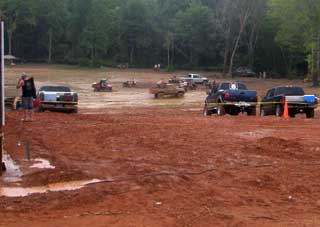 weights. At about 6:30, Steve arrived back on site, and I could see the look of amazement on his face as he appeared on the top of the hill, staring down at our pristine white bus as if it was sitting on a deserted island in the middle of the Pacific Ocean. After conversing with Steve, I approached the owners and they presented their plan to scrape off the top three or 4 inches of mud from the road with a tractor, and then to tow the bus out. Shortly after this, they began scraping, and the rest of us continued stressing.
weights. At about 6:30, Steve arrived back on site, and I could see the look of amazement on his face as he appeared on the top of the hill, staring down at our pristine white bus as if it was sitting on a deserted island in the middle of the Pacific Ocean. After conversing with Steve, I approached the owners and they presented their plan to scrape off the top three or 4 inches of mud from the road with a tractor, and then to tow the bus out. Shortly after this, they began scraping, and the rest of us continued stressing.
By 7:45, the second band ‘Matt Stillwell’ was just finishing their set and we loaded our gear onto the deck to prepare for our show. At about 8:15 we were ready to go, and Puff asked me 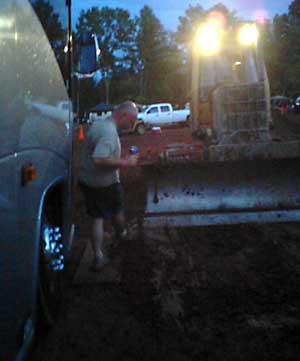 if there was anything specific he should say regarding Rhett’s introduction. I told him to mention a few of Rhett’s radio hits, and that Rhett has just released a new CD of hunting songs with Michael Waddell called ‘Bone Collector’ which is available at the merch area. So, of course, Puff delivers an intro void of any of this, and after rambling some fast talking Alabama DJ bullshit, exudes “Ladies and gentlemen please welcome to the stage Rhett Akins.”
if there was anything specific he should say regarding Rhett’s introduction. I told him to mention a few of Rhett’s radio hits, and that Rhett has just released a new CD of hunting songs with Michael Waddell called ‘Bone Collector’ which is available at the merch area. So, of course, Puff delivers an intro void of any of this, and after rambling some fast talking Alabama DJ bullshit, exudes “Ladies and gentlemen please welcome to the stage Rhett Akins.”
Midway through our set, we all witnessed what was perhaps the most exciting event of the day, that of our bus slowly moving up the hill, towed by a large tractor. I literally wanted to stop mid song and applaud as I saw it slowly disappearing from site, well on its path to solid ground. Upon this, I waved Kelly over to the stage, and asked her to organize after show transportation to the bus. She went and found Puff and requested that he had a ride ready for Rhett as soon as the set was complete, and transportation for the rest of us and our gear a few minutes later. We rocked the small but enthusiastic, mud covered crowd for about 60 minutes total, and needless to say Rhett walked off the stage to find no vehicle awaiting him. After quickly packing up our gear and clearing the stage, I went and found Puff and said “Where’s the ride? Rhett’s been waiting 10 minutes already.” “It’s not here yet?” he exclaimed. “I asked them to send somebody 5 minutes ago.” And with that, he quickly hopped in his van and drove off, never to be seen again. I can’t say I was surprised as it had long become obvious that either his memory, or his sincerity was literally nonexistent.
I found one of the owners, organized our exit, and a few minutes later we were back at the bus on the street above. The valley of mud now behind us, we could finally begin to relax. None of this kind of turmoil is ever funny in the moment, but as time is the ultimate healer, we were quickly able to see this horrific day a little more cheerfully, although we we’re now completely drained. Kelly grabbed the bottle of Crown and some solo cups, and poured a much-needed round of shots. I proposed a toast to cap off our adventures in the valley of mud. “Here’s to friends with tractors!”
I would like to add a special thanks to the guys with the big tractors, and everyone in Ashton Shepherd’s group for their generous sharing of backline, and overall team spirit.
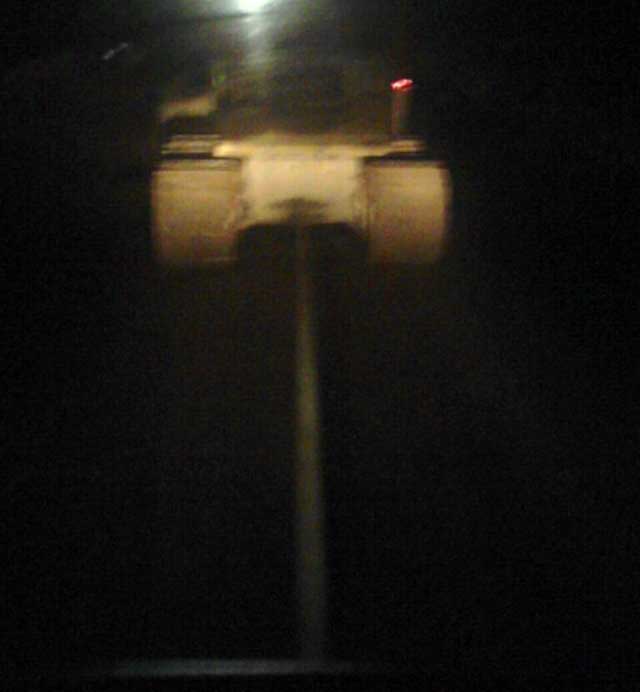
Success in the Music Business is all about Competence, Integrity, and Relationships
Getting a good gig is largely dependent on having the right connections. While talent and skill are certainly important attributes, knowing somebody on the inside track can be an extremely important factor when it comes to finding work.
Since my arrival to Nashville, one of the more memorable and interesting tours I’ve been fortunate enough to be a part of was the Toby Keith ‘Shock’ N’ Y’All’ tour of 2003. I had been in Nashville for about a year with no steady income to speak of, when I received a tip from friend and Toby Keith drummer, Dave MacAfee, that Toby was in need of a new guitar tech. I had previously met Dave at some of the Tuesday night hangs at the Fiddle and Steel, where I had sat in with the band he was playing with on a few occasions. Although I had moved to Nashville to pursue a career as a player, I decided to check out this opportunity, as I was badly in need of some steady income by this point.
Dave gave my number to Toby’s tour manager who hired me after a brief phone interview. I had no previous experience as a guitar tech, but I was hungry for work, and eager to learn. Ultimately, it was Dave’s recommendation that got me hired. If I didn’t know Dave, it is unlikely that I would have even heard of this opportunity. But even more importantly it was Dave’s recommendation to Toby’s tour manager that gave me instant validation. Dave had been already working for Toby for several years by this point in time, and his backing was all I needed to get my foot in the door. Once I was “in”, all I had to do was make good on my commitment, which I did.
If I hadn’t already established a reputation of being a competent, trustworthy, easy to work with player, Dave never would have recommended me for this position. In reality, if I didn’t have my act together, I probably would have never even met Dave, as he is a standup guy and a consummate professional who associates with others who are like-minded. While the old cliché “It’s not what you know, it’s who you know” is essentially true, having your act together doesn’t hurt either.
A Taste of Nashville
The Nashville Musician’s Survival Guide is meant to help musicians, songwriters, artists, and everyone that moves to Nashville for a career in the music business find their way. I have done  my best to describe in words what it’s like to live and work in this town. But words can only go so far. If you’re already here and working at your career in music, you’ve got a pretty good idea about the landscape. But for those that are considering relocating to Music City, the book, and the website, will contain as many photos as possible, to help give a taste of the town.
my best to describe in words what it’s like to live and work in this town. But words can only go so far. If you’re already here and working at your career in music, you’ve got a pretty good idea about the landscape. But for those that are considering relocating to Music City, the book, and the website, will contain as many photos as possible, to help give a taste of the town.
So this morning I drove into the city with my digital camera and tripod to try to capture some of the “uniqueness” this place has to offer. I parked in the big parking lot across from the Tin Roof on Demonbreaun, just a few hundred feet from the ‘roundabout’ at the beginning of Music Row, and set out on foot. The first photos I shot were of the controversial statue that sits right in the middle of the roundabout. I remember  the public outcry when this statue of naked people making music and dance was first built. Honestly, I don’t see what the big deal was all about. The way I see it, the statute is elegant and tasteful and represents the musical melting pot of this city.
the public outcry when this statue of naked people making music and dance was first built. Honestly, I don’t see what the big deal was all about. The way I see it, the statute is elegant and tasteful and represents the musical melting pot of this city.
Next it was on to the BMI building, a massive piece of architectural wonderment that I find to be both awe-inspiring and menacing, kind of like the music business itself. On the other side of the roundabout circle, there’s a statue I had never noticed before, that of a man sitting at a piano in Owen Bradley Park. Right around the corner is BMI’s little brother, the ASCAP building, which sits right at the beginning of ‘The Row ‘. After snapping some photos of these obvious landmarks during this now sweltering 90° morning, I walked a little further down 17th grand, one of the two one-way streets that comprise Music Row.
I’ve driven on these streets hundreds of times over the years, passing by the studios, publishers, and innumerable brick buildings that house the core of the Nashville music business community. But on this day, by foot, everything looked brand-new again, and this  gave me the feeling of the mysterious city that this was for me upon my arrival eight years ago. As I slowly walked down the long lonesome sidewalk of 17th Avenue, I realized how much of this city, this place, I had never really seen. As I stood on the curb staring curiously at these historic and iconic landmarks, I began to perceive Nashville like a newcomer again. I became curious about what was around each corner, about what was going on behind the doors of these buildings built upon music enterprise.
gave me the feeling of the mysterious city that this was for me upon my arrival eight years ago. As I slowly walked down the long lonesome sidewalk of 17th Avenue, I realized how much of this city, this place, I had never really seen. As I stood on the curb staring curiously at these historic and iconic landmarks, I began to perceive Nashville like a newcomer again. I became curious about what was around each corner, about what was going on behind the doors of these buildings built upon music enterprise.
A car pulled up to Curb Records and out popped a well-dressed woman carrying a briefcase. An older gentleman in a leisure suit exits the Sony building talking on a cell phone. A young man carrying a guitar case disappears down an alley next to one of the recording studios. Where are they going? What are they all doing? This hot morning stroll was putting me in the kind of mindset I was  in when I first came to town, curious and full of questions, searching for enlightenment. After working in the Nashville music industry for eight years, I rarely go out exploring anymore, as I tend to go to specific places of business as required.
in when I first came to town, curious and full of questions, searching for enlightenment. After working in the Nashville music industry for eight years, I rarely go out exploring anymore, as I tend to go to specific places of business as required.
About an hour after this photographic journey began, I returned to my car, as the heat was getting to be unbearable. I took lots of photos, but realized there’s so much more here to capture. I plan to go out and do this again several more times before I am done with this project.
So for everyone that is new to town, or thinking about moving here, hopefully, these photos will give you a little taste of Nashville. I hope you enjoyed the tour.

Rhett Akins in Reinholds; Don’t Take Magic for Granted
It was Saturday morning when I suddenly was awakened in my bunk to the sensation of a rough ride on a bumpy road somewhere in southern Pennsylvania. Our destination was the little town of Reinholds, PA, and a short while later we pulled our tour bus in to the parking lot of the Black Horse Lodge and Suites, just a few miles from the concert site. Just after noon we rode the bus over to the site, commenced load in, and enjoyed a healthy lunch.
The event coordinator, Larry Wolf, was on top of the details, as he has been helping to organize this annual outdoor summer concert series for over 20 years. The walls on the backstage greenroom were like a who’s who in country music history, with signed posters of artists like Reba McEntire, Johnny Paycheck, Brad Paisley, Kenny Chesney, Tracy Lawrence, and many others lining the walls. After lunch we began our sound check, and this would be the second day in a row that we would build an arrangement for one of Rhett’s recent chart toppers ‘All Over Me’, which was cut by Josh Turner. When Rhett began strumming and singing this piece on his acoustic, it seemed to warrant a feel somewhat reminiscent of Little Feet or Dr. John, and we brought a hint of New Orleans to this hot humid afternoon in the north.
A few hours later, after our typical routine of showers at the hotel and a catered meal, we were back on the bus waiting for showtime while a local opening band performed. Midway through the opener’s set the crowd of 2000 plus ran for cover when a torrential downpour let loose. We feared that we were done for the night, but fortunately about a half-hour later the rain subsided and the opener returned to finish their set.
We hit the stage at about 9:15 with our usual set openers of ‘Down South’, ‘I Brake for Brunettes’, and ‘Don’t Get Me Started’ and the crowd responded warmly. As Pennsylvania is literally the hunting capital of the world, we could do no wrong by playing some of the cuts from Rhett’s recent hunting album ‘Bone Collector’. Despite never hearing these songs before, the audience instantly fell in love with songs like ‘My Baby Looks Good in Camouflage’, ‘Granddaddy’s Gun’, and ‘Duck Blind’.
Our shows with Rhett have evolved into an interesting mix of music that represents every facet of his 15 year career. On this show, as on most shows at this point, the audience would hear his first wave of radio hits from the mid to late 90s, songs from recent releases ‘People like Me’ and ‘Down South’, some of the new hunting songs, a few classics from his idols, and a barrage of original versions of his most recent songwriting chart busters recorded by other artists. This all makes for an action-packed, exciting show, and the crowd’s energy on this muggy summer night was building steadily throughout our electric 90 minute performance. By the encore, the sea of audience members sitting in lawn chairs could still be seen beyond the couple hundred that were now standing directly in front of the stage.
We are fortunate that nearly all of our shows seem to have some kind of magic happen at different points throughout the performance. But on this particular night Rhett and band were particularly on, the crowd was in tune, the sound was happening, and it was one of those magical nights where everything seems to come into alignment. The kind of musical inspiration that we, as performers, live for. It’s hard to imagine that anybody, band or audience, could go away from a concert experience like this without feeling a little better about life.
Inspiration on this level isn’t something you can plan on, or make happen, so when it does, don’t take magic for granted.
Getting to the Heart of a Song
Our weekend tour began Thursday at midnight, when we pulled out of Nashville, bound for Wake Forest, North Carolina. By early afternoon on Friday, we were loading our gear into Crossroads, a large nightclub located in a strip mall that would be home for most of this day. After a couple hours of setting up and dialing in our sound we began to build an arrangement for one of Rhett’s most recent songs to make the charts, All About Tonight, which was cut by Blake Shelton. In most touring situations, when an artist needs their band to learn new material, band leader will distribute CDs, and the players will learn the parts that were created by the studio musicians that cut the original tracks. But the situation in the Rhett Akins band is far from the typical Nashville way of doing things.
During sound check, he will sing the new song, accompanying himself with the acoustic guitar while we listen and begin thinking of parts. Sometimes, Rhett will hum a signature lyric and convey other ideas, while we begin piecing an arrangement together. Usually two or three run-throughs at full volume, and things start coming together. There’s usually some conversation and an open ended exchanging of ideas between Rhett and the band that enable these songs to take shape.
This is the fourth or fifth time we’ve done this in the past couple of years, and as Rhett continues to have major cuts with popular artists, it only makes sense to continue this trend. This unique approach is quite exciting, as it allows the individual band members to create their own parts, ultimately allowing us to become more connected with his songs than we would if we were just learning somebody else’s parts. Each of the players in Rhett’s band has their own strengths; Pasi on drums, Clint on bass, Scott and myself on guitar, we each bring something to the table. The fact that Rhett allows us to participate in the arranging of his songs is the ultimate sign of respect.
In Nashville, the journey a song takes is typically far more diluted. In most situations a songwriter, or more than likely two or three co-writers, write the song, and then record a rough acoustic guitar and vocal “work tape”. This work tape will then be sent to a group of studio musicians who will record a demo based off of that rough recording. This demo will then be pitched to different artists, and when an artist decides to cut the song, another group of studio musicians will record the final album version based off of the demo. When that artist goes on tour, his touring band will learn the parts that were created by the studio musicians that cut the album tracks. So the touring band is learning, usually note for note, parts that were created by studio players, who copied or interpreted parts created by other studio players, that created parts from the writers work tape. Three generations removed from the original writers spin or “vibe” on the tune. Obviously this can work because there are plenty of successful touring artists and bands.
Rhett’s band and myself are very fortunate to be in a situation that allows for creative participation with the music we play. I’ve been in plenty of situations where that was not the case, and I must say this is far more organic and rewarding. It’s kind of funny, I’ve never even heard some of the other artists radio versions of these songs. In a few situations, the band actually began working up these arrangements and playing his tunes before they even got demoed or cut by other artists. This was the case with Kiss My Country Ass, and Put a Girl in It. I realize this isn’t practical for all band situations, and I am greatly appreciative of my good fortune that allows me to get to the heart of a song.
The Nashville Musicians Survival Guide Update
I am now about fourteen months into this project and am happy to say that there is an end in sight. As I have about 95% of the writing finished, I decided it was time to turn it into an unformatted hard copy so I could give it a read thru and assess. So last week Kelly turned it into a PDF and we ordered 3 copies thru Café Press which we received in the mail last Saturday. Even though it’s only a first draft and there’s a lot to still be done, it was pretty exciting to open the package and see my work finally in print.
All week long my daily ritual has been to wake up early, eat breakfast, and tear into the reading with a pen in hand. I’ve been fixing some grammar and punctuation mistakes, assessing the overall flow, and making notes about potential changes and images to obtain. I’m almost thru with this first read thru/edit and so far I’m quite pleased. Among a few of the big tasks that lie ahead are the writing of the last chapter “Define Making It” and the Rhett Akins interview on songwriting.
I’m writing this from the road in a hotel room in Wake Forest, North Carolina (tonight I’ll be performing with Rhett at the nightclub, Crossroads, in town), and I just finished the interview. As Rhett is on a mega roll with his writing as of late, his perspective was deep on this subject and I can’t wait to transcribe and edit our 55 minute exploration.
I still need to find a couple dozen more appropriate quotes, a few specific photos and images, write the acknowledgements, and the glossary, and of course make all the editing changes from my read thru. Then I need to hire a professional editor, an interior designer, and find the most affordable way to get this printed. To learn more about these final steps I ordered the critically acclaimed book “Dan Poyntner’s Self Publishing Manual”. One last thing, I also plan to add one or two of my “Flood Blogs” to the book, with a brief summary, as this was one of the most important things to ever happen in Nashville.
So if all goes according to plan, this book will complete and ready to ship sometime in September. It’s been a long road, but ultimately, the road has just begun. Well that’s it for now, I’m off to the show.
What is a Musician?
What is a musician? A musician is one who makes music. I believe that if you can make music on any level, by any means, then you are a musician. While there are varying levels of musicianship and musical expression that one can possess, a person’s level of musicianship and their music career or lack thereof are not always related. Many professional musicians are great players while other pros are not. Some “amateur” musicians play with more emotion and proficiency than some pros.
In the critically acclaimed book “This Is Your Brain on Music”, author Daniel Levitin points out that no known human culture now or anytime in recorded history lacked music. Some of the oldest artifacts found in human excavation sites are musical instruments. It’s only been in the last 500 years of our own culture that society has divided itself into two groups, music performers and music listeners. In many non-industrialized cultures, music making has always been, and still is as natural an activity as breathing and walking, with everyone participating. Before television came along in our own society, many families played music together for entertainment. Most modern day music listeners have the ability to recognize wrong notes, remember melodies, and tap their feet in time to music, which according to Levitin is an activity that involves a process of meter extraction so complicated that most computers cannot do it. An argument could be made that a person who possesses even a minimal amount of music making abilities is a musician.
Our culture tends to put emphasis (perhaps at times, too much emphasis) on technical virtuosity. While understanding music theory and being technically capable can enhance the performance of some musicians, it is not at the essence of human expression through music. We only need to look back to the blues music of the last century, the work songs of the slaves, or the primal rhythms of Africa to understand the power and depth of human emotion that “non technical” music can convey.
Music exists for everyone, and the performance of music should not be reserved to the few that happen to excel at it. If you enjoy the feeling you get when you strum a guitar chord or strike a drum, that is reason enough to make music. If you like to sing, even if it’s only in the shower, then you should sing. Music is perhaps the oldest form of communication, and should be continually explored by all people from all walks of life. What is a musician? Perhaps a musician is simply a human.
